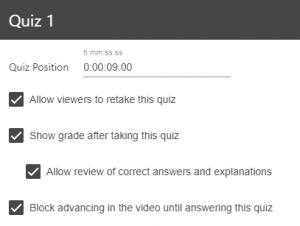Did you know you that you can add quizzes to your Reflect recordings? This feature can add a level of interactivity to recordings and presents a number of learning and teaching opportunities. You can use the Quizzes guide to discover how to add a quiz to your recording. This article will highlight how to use Reflect Quizzes in practice including writing good MCQs (Brame, 2013).
There are currently three question types in Panopto: True/False, Multiple Choice and Multiple Select. The Quiz’s Settings, shown in Figure 1, can change how your students experience the recording. One of the most powerful of these settings is ‘Block advancing in the video until answering this quiz’; this will prevent learners from jumping ahead, disabling the timeline and/or contents until the quiz is completed. The learner is not required to get 100% or a threshold pass-mark to continue, but it enables them an opportunity to consider and assess their understanding before moving on. You can deploy multiple quizzes throughout a recording, so this feature can be helpful to break-up material.

Figure 1: Quiz Settings
The further setting options allow students to retake a quiz and determine whether you will display a ‘grade’ to them upon completion of the quiz. The ‘grade’ is a score, with a point awarded for each correct answer. Within a Quiz, you can provide feedback on each question, but only if the correct answer was selected. To enable feedback, select the ‘Allow review of correct answer and explanations’ option (this is only available if the ‘Show grade after taking this quiz’ is selected). You can have as many quizzes in a recording as required and these can be positioned at any point in a recording. If you ever need to reposition a quiz within a recording, you can adjust the time code in the Quiz Position within the Settings seen in Figure 1.
As the educator and owner of a Reflect recording, you can access all the results of a quiz and individuals’ attempts via the Settings of the recording. The results of each quiz are treated independently and are not aggregated for the whole recording. However, you can download a full set of results, which has a breakdown by question. How you set-up a quiz and access to result data is explained in more detail on the Reflect website and the Panopto help pages.
The Quiz feature has a number of learning and teaching benefits. Quizzes are always added post recording, therefore you could retrospectively add a formative quiz to the end of any lecture recording, to enable learners to test their understanding and ensure the Intended Learning Outcomes of the lecture were met. This type of quiz writing requires some consideration. This guide by Brame (2013) provides advice on how to author effective Multiple Choice Questions (MCQs). Brame (2013) identifies three elements to an MCQ, the authored problem known as the ‘Stem’, the correct answer(s) and the alternative options, described as ‘distractors’. It is often the latter of these, the ‘distractors’ that are the hardest and most important to construct, as they should all be plausible to enable critical thinking. Brame’s (2013) guide again provides helpful tips and advice on authoring these.
One use of Reflect that is becoming more commonplace is to record preparation or prior learning materials in a practice called Flipped Learning. The use of pre-class quizzes has been cited as a ‘highly successful’ (Bishop and Verleger, 2013, p.9) method of ensuring learners engage in these materials. You can embed these questions within the recordings using the Quiz feature to facilitate this, and could use the ‘Block advancing’ feature to ensure all the materials are engaged with. However, a word of warning here, it is advisable that the questions are only answerable by watching the recording. If learners can Google the questions/answers, they may take shortcuts, circumventing the need to watch the recording and enabling their progression through the materials.
Tobin and Honeycutt (2017, p.451) express how creating the ‘connection’ between the out-of-class and in-class learning is vital in Flipped Learning. One approach to this is using the pre-session recordings to outline how the learning will be used in the classroom and explain what learners are expected to have completed in advance. A questioning technique, that would definitely negate ‘Google shortcutting’, is the use of Instruction Clarification Questions (ICQs). Commonly used within Teaching English as a Foreign Language (TEFL) courses, ICQs are a method of ensuring learners have understood what is expected of them within activities. The same technique could be used in pre-class recordings, facilitated through the Quiz feature and promote engagement with the materials.
Hopefully this article has opened your eyes to the potential of using Quizzes in Reflect recordings and given you some hints and advice of how they could be used in practice. If you would like to discuss any further ideas and get support using the quizzes please get in touch (lli@le.ac.uk). If you have already used the Quizzes in Reflect it would be great to hear your experiences.
References
Brame, C., (2013) Writing good multiple choice test questions. Available at: https://cft.vanderbilt.edu/guides-sub-pages/writing-good-multiple-choice-test-questions/ (Accessed 8 November 2018)
Bishop, J.L. & Verleger, M. (2013) ’The Flipped Classroom: A Survey of the Research’, 120th American Society for Engineering Education Annual Conference & Exposition. Atlanta, Georgia, 23-26 June. Washington: American Society for Engineering Education, Available at: http://www.asee.org/public/conferences/20/papers/6219/view (Accessed 8 November 2018)
Tobin, T.J. and Honeycutt, B. (2017) ‘Improve the Flipped Classroom with Universal Design for Learning’, in Vu, P., Fredrickson, S. and Moore, C. (eds.) Handbook of Research on Innovative Pedagogies and Technologies for Online Learning in Higher Education. USA: IGI Global, pp. 449–471.

 Subscribe to mmobbs's posts
Subscribe to mmobbs's posts
Recent Comments